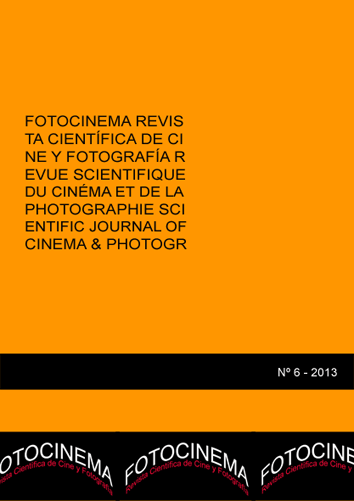La fotografía como estandarte de la verdad y el progreso: estudio sobre la iconografía fotográfica en la medallística (1880-1920)
DOI:
https://doi.org/10.24310/Fotocinema.2013.v0i6.5912Abstract
Resumen:Desde el momento de su creación a mediados del siglo XIX, la invención fotográfica representó un cambio profundo en la mentalidad de la sociedad decimonónica en lo relativo a su impacto en la reproducción y diseminación de las imágenes visuales. Durante las primeras décadas siguientes a su invención, los entusiastas de la fotografía propulsaron un discurso de superioridad mimética de la misma por sobre las artes visuales tradicionales, sobre la base de la supuesta objetividad absoluta de su registro óptico-químico. La fuerza de esta mentalidad discursiva del nuevo paradigma visual se reflejó en la literatura y demás expresiones culturales, incluyendo las propias artes plásticas. A través de un análisis iconográfico de un conjunto de medallas del período se pueden identificar los signos, códigos y discursos relativos a la fotografía como reflejo de las mentalidades positivistas imperantes de la época.
Abstract:
Since its invention in the first half of the nineteenth century, photography represented a profound change in the mentality of European society regarding its impact in the reproduction and dissemination of visual images. During its initial developmental stage, fanatics of the new medium gave impulse to a discourse of mimetic superiority of photography over traditional visual arts, based upon the alleged absolute objectivity of its optical-chemical registry. This discursive mentality reflected its influence in literature, as well as in other cultural expressions, including the visual arts. Through the implementation of an iconographic analysis of a sample of award and commemorative medals of this period, this article looks to identify those signs, codes and discourses related to photography as symbol of progress and absolute truth within the positivism paradigm.
Keywords: Photography; iconography; medallic art; visual images; mentalitiesDownloads
Metrics
Downloads
Published
How to Cite
Issue
Section
License
All contents published in Fotocinema Revista científica de cine y fotografía are protected under the Creative Commons Attribution-NonCommercial-ShareAlike 4.0 International (CC BY-NC-SA 4.0) license. All about this license is available in the following link: <http://creativecommons.org/licenses/by-nc-sa/4.0>
Users can copy, use, redistribute, share and exhibit publicly as long as:
- The original source and authorship of the material are cited (Journal, Publisher and URL of the work).
- It is not used for comercial purposes.
- The existence of the license and its especifications are mentioned.
There are two sets of authors’ rights: moral and property rights. Moral rights are perpetual prerogatives, unrenounceable, not-transferable, unalienable, imprescriptible and inembargable. According to authors’ rights legislation, Fotocinema. Revista científica de cine y fotografía recognizes and respects authors moral rights, as well as the ownership of property rights, which will be transferred to University of Malaga in open access. The property rights are referred to the benefits that are gained by the use or the dissemination of works. Fotocinema. Revista científica de cine y fotografía is published in an open access form and it is exclusively licenced by any means for doing or authorising distribution, dissemination, reproduction, , adaptation, translation or arrangement of works.
Authors are responsable for obtaining the necessary permission to use copyrighted images.













13.png)




